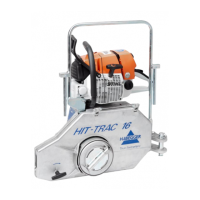User Guide
TGT. 27.09.2017 Technical Page 17 of 20
©Copyright by Habegger Maschinenfabrik AG Version 02 / 27.09.2017
Restart under load:
1. Release chain brake
2. Quickly pull the throttle lever so that the motor can reach the required speed and the centrifugal clutch can instant-
ly deliver the required torque.
- Caution! Allowing the coupling to slide through for too long leads to overheating and early wear and tear.
When working at high altitudes or in unfavourable climate conditions:
- Optimise carburettor settings or
- Reduce load accordingly.
If being used regularly in mountainous areas, a special carburettor can partially compensate for the reduction in power.
The motor settings must be implemented according to the STIHL operating instructions or following consultation with the
manufacturer.
5.4 Lowering
To lower the load or relieve tension in the rope, release the brake:
1. Power off motor.
2. Swing hand crank out at a right angle
3. Turn handwheel in anticlockwise direction.
Turning the handle in this way reduces the preload force on the brake plates until the brake housing starts to move. The rope
speed is dependent on the speed of the hand crank.
- Caution! The driving plate cams can be damaged.
Do not release the hand crank during movement and do not pivot during movement.
To pause the lowering, stop the handwheel. This raises the contact pressure on the brake plates until the brake housing and, consequen-
tially, the load come to a stop. As soon as the brake housing stops, turn the hand crank 1/4 of a revolution backwards and pivot it back in.
Turn the hand crank a 1/2 revolution backwards in a clockwise direction after the rope has been released so that the spindle can be re-
leased from the nut and doesn’t seize up when it cools down.
As energy produced during lowering is converted into frictional heat, the distance the load can be lowered by is restricted to
protect the lowering brake against overheating. The table provides the maximum values:

